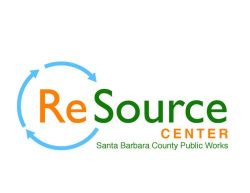
How does a MRF work?
This new state-of-the-art waste management facility will increase our community’s recycling rate to above 85%, generate resources, such as green energy and compost, and dramatically lower local greenhouse gas emissions.
How does a MRF work?
Once you throw something away, it never really goes away. For residents of the South Coast, Santa Ynez Valley, and the unincorporated areas of Santa Barbara County, it goes to the ReSource Center!
Currently plastics #1 and #2, dry and clean cardboard, and dry and clean paper, glass, and metals are being sorted out at the Materials Recovery Facility (MRF) and collected for recycling. All organic materials, including wet paper (used paper towels, too!), food scraps, plant material that can't go into the green waste, and wet cardboard, are getting pulled out to be composted.
The videos below show the journey of our trash, recyclables, and organics once they get to the ReSource Center.
Step One - The tipping floor. Trash and recyclables are dumped here.
From here, recyclables are fed into the processing machines. This primarily evens out the amount of material to a consistent level before it's sorted by size. This also breaks bags open.
Up next is the trammel. Both trash and recyclables come here after initial infeed, however not at the same time. Trash and recyclables are processed in different shifts, as different machines are used. This is the first separation by size. Smaller objects fall through the holes while larger objects come through the end.
After the trammel, material goes through the Trom Screen. This is the first screen that materials encounter after going through the trammel. This separates heavy from light, and smaller items from larger items.
The material then goes through another screening, as seen in the video below.
Next is the optical sorter. This is an optical sorter used in the middle of the process. Over a dozen of these are used for the trash and recyclables. Each has a different material goal related to size, type, and color.
More sorting! The equipment used in the video below sorts paper materials.
In the next video you can see organic waste exiting stage left. The organics are getting sent to the Anaerobic Digestion Facility.
The recyclables have finally made it through their journey. In the next video they are getting sent to be bailed and shipped off to be recycled!
So, what's next for the recyclables? The recycling market can change daily. Our recyclables get sent to manufactures who can use them to create new products. However, you may have noticed that the material sorting process is extremely intensive. It's great that we can recover materials and prevent them from going to the landfill, but it's always better to not produce waste in the first place. Remember, refuse, reduce, reuse, rot, and recycle, in that order!
There are over one-million moving parts in the MRF at the ReSource Center. All of these pieces play an important role in making sure our waste is sorted correctly. This system uses a mix of sorting tools, including infrared lights, screens, and the human hand.
Check it out for yourself! Schedule a ReSource Center Tour by clicking here.
Related Materials
- ReSource Center Experience
- ReSource Center Goals & Benefits
- ReSource Center Photos
- ReSource Center and Tajiguas Landfill Tours
- Directions to the ReSource Center
- Virtual ReSource Center Tour
- Project History
- SB 1383
- SB 1383 Organics Collection
- Green Franchises
- County Waste Facilities
- Virtual Waste Reduction Library
- Teacher Resources
- Waste Reduction Tours
- ReSource Center in the News!
- We’re in the Press!
- Baron Ranch Restoration Area
- Santa Barbara County Regional SB 1383 Food Recovery Plan
- Setting Up a Food Recovery Plan
- Online Recordkeeping System FAQs
- SB 1383 Edible Food Recovery Tools
- AB 1276 – Single-Use Foodware Accessories and Standard Condiments
- Program Exemption Application
Related Articles
-
The ReSource Center is Happening and Redefining Waste Recovery!
April 15, 2021 by Carlyle Johnston - ReSource Center -
Biomass Magazine Features Article on Resource Recovery Project
December 01, 2016 by Carlyle Johnston - Trash, ReSource Center -
Construction Begins at the Tajiguas Resource Recovery Project
December 03, 2018 by Carlyle Johnston - ReSource Center -
Final Contract to Build the Tajiguas Resource Recovery Project Approved by Board of Supervisors
September 18, 2018 by Carlyle Johnston - ReSource Center -
Planning Commission to Review Design Changes for Tajiguas Resource Recovery Project
August 22, 2017 by Carlyle Johnston - ReSource Center -
New Tajiguas Resource Recovery Project Video
June 19, 2018 by Carlyle Johnston - ReSource Center -
Public Financing of the Resource Recovery Project Approved by the Board of Supervisors
October 16, 2018 by Carlyle Johnston - ReSource Center -
Take a Tour of the ReSource Center!
August 20, 2021 by Sam Dickinson - ReSource Center -
Over 2.8 Tons of Waste Removed on Coastal Cleanup Day
September 28, 2023 by Sam Dickinson -
Sustainable Purchasing Guide from the RRWM
December 09, 2023 by Kaitlyn Haberlin - Reduce & Reuse -
Meet Food Waste Freddie! Your Local Food Waste Hero.
April 10, 2024 by Sam Dickinson - Organics